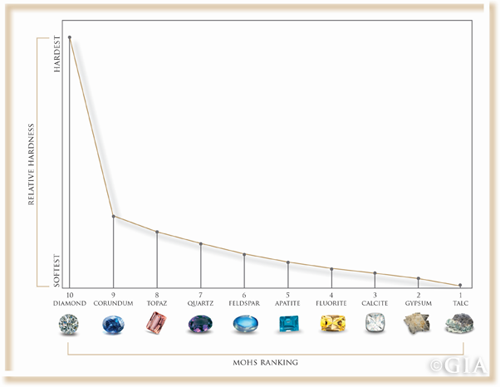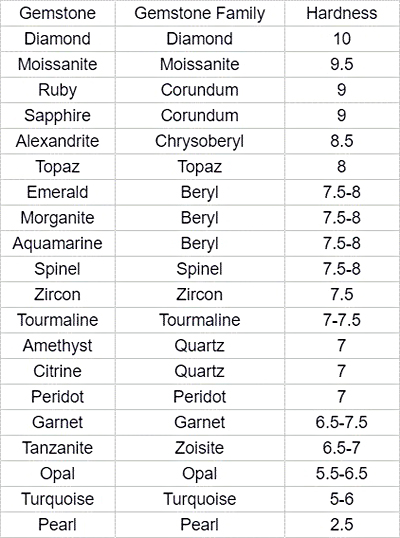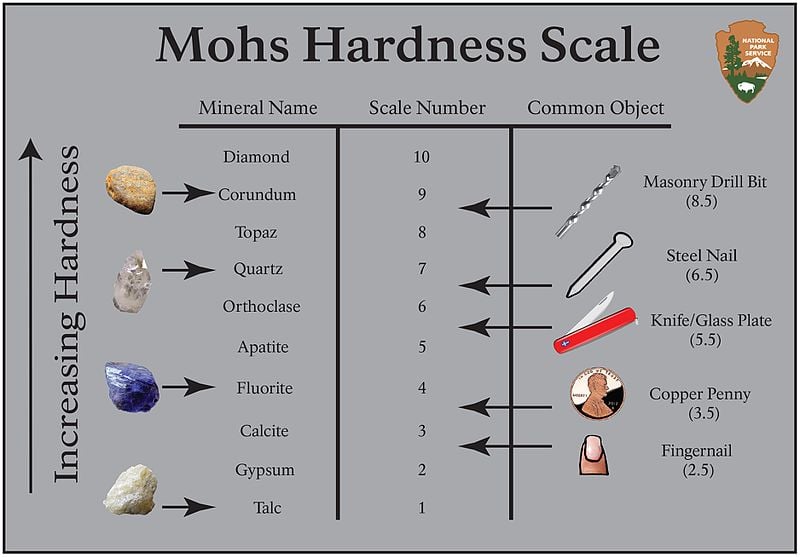The Best Colored Gemstones
Posted by Koorosh Daneshgar on Feb 1st 2018
Why are diamonds the best gemstone for an engagement ring?
In the modern world, people have been branching out and trying adventurous gemstones for their engagement rings. However, you can’t beat the original. In this post we will be discussing the differences between diamond and the other popular engagement stones and why diamonds have been the most consistent and popular engagement stone and why a diamond really is forever!
Diamond’s popularity as a gemstone is heavily reliant on several factors; not least of which is its ability to withstand wear. Diamonds have a combination of three factors that make them so great for everyday wear: hardness, toughness and stability.
Hardness
People are always told that diamonds are the hardest mineral in existence on earth, and that is true (of commonly found minerals). But what does that mean? Hardness is simply defined as how well a gemstone resists scratches or abrasions. Diamond earns the distinction of being the hardest mineral because the only mineral that can scratch it is itself. Diamond sets the gold standard for hardness of gemstones.
In order to judge gemstones’ hardness, Freidrich Mohs originated a scale in 1822 that eventually became known as the Mohs Scale.

Image found from the Gemological Institute of America website.
The scale is quite simple to understand. At the time, Mohs took ten gemstones and ranked them based on what stones they can scratch versus what stones can scratch them. E.g. a quartz (a gemstone family that includes amethyst and citrine) is at a seven on the scale and can scratch anything that is a seven or below. A corundum (a gemstone family that includes rubies and sapphires) at a 9 can scratch everything at a nine or lower.
However, a downside to the scale is the assumption that the difference between the numbers is to scale; that the difference in hardness between a ten and nine is the same as a nine to eight. When seeing the numbers without the graphic scale, many people assume that the differences are the same. However, as you can see in the graphic representation above, you can see that the differences in the scale are not constant. All gemstones, minerals or jewelry materials are given a ranking on the Mohs scale.

Listed above are a collection of some of the most popularly used gemstones in the jewelry industry (whether as a birthstone or a popular jewelry or engagement ring stone). We, as a jewelry store frequently get requests for certain stones in engagement rings: sapphire, ruby, moissanite, emerald, tanzanite, opal, pearl, garnet or alexandrite. Some gemstones are given a minimum and maximum ranking on the scale. This is because some gemstones vary slightly in chemical composition or their resistance to scratching in certain directions as a result of their crystalline chemical structure.
Any gemstone listed at or below a 7 on the Mohs scale poses high levels of risk of scratching or abrasion through everyday wear. This is from one major factor: quartz falls at a seven on the Mohs hardness scale. Quartz is one of the most commonly found minerals on earth. Quartz can be found in dirt, in granite and several other prominent substances that we come across in our everyday lives. Because of its prominence, small grains of it can even be found in dust. As dust settles on gemstones or metal, improper cleaning can result in scratches or abrasions to gemstones.
Also, we wear rings on one of the most active parts of our body: our hands. We are constantly using our hands. That means that stones in rings with subpar hardness and toughness (we will go into toughness next) will be less likely to survive your day-to-day activities without scratching.
Another fact that is good the know: you shouldn’t store diamond in a jewelry box with most other gemstones because it is more likely to scratch the stones if they bump into each other. Also, when a diamond is loose in metal, because metal is far less hard than diamond, loose diamonds can wear metal down faster and cause metal to break and cause stone loss. Always be sure to bring rings in regularly for proper cleaning and inspection to avoid stone loss.
Toughness
The most common belief is that gemstone hardness and toughness are the same thing. However, gemstone toughness is how well a gemstone resists breaking or chipping. Gemstone toughness is a function of its chemical structure. The extreme pressure and temperature causes atoms to bond more tightly in some directions than others.

Above is shown a graph that shows relative toughness versus the Mohs Scale. This scale is a good, albeit imperfect, indication of toughness of most gemstones. There is no easily illustrated scale that demonstrates the toughness of a stone. Scientifically, all items fall on the fracture toughness scale which, according to GIA, measures the work required to separate two surfaces of a crystal along a certain crystallographic plane. However, the complex nature of this testing process means that it is not as easily organized as the Mohs scale.
Many people, because they have learned that diamond is among the hardest minerals currently found on earth, they believe that diamond is indestructible. However, diamond has a good toughness but is not indestructible. Many gemstones, including Jadeite, Nephrite Jade and Sapphire have a far higher level of toughness. However, diamond’s combination of toughness and hardness makes it a more than ideal gemstone for everyday wear (especially when mounted protectively in a ring).
The scale above also shows how poor certain gemstones are suited for everyday wear. Emerald, a member of the beryl family- yet notoriously more fragile than morganite or aquamarine- is a very brittle stone due to its high quantities of natural cleavage points and internal imperfections (something that does not frequently exist in fine quality aquamarine and morganite). Zircon, pearls, tanzanite, opal, turquoise, and topaz fall to the fair or poor end of the scale, making them less-than-exceptional choices for jewelry that receives regular or repeated shocks such as rings or bracelets.
Stability
When people hear something is stable, they tend to think of the primary definition of stability: (of an object or structure) not likely to give way or overturn; firmly fixed. That definition sounds like the way you would describe how gemstones were set in a ring, not the gemstone itself. The definition though, as it relates to jewelry, is how well a gemstone resists chemicals and temperature changes.
Diamonds have excellent stability. They are resistant to virtually all known acids and can endure incredible heat before burning. The few things that can damage a diamond are thermal shock (damage caused by sudden extreme temperature changes) and burning.
Diamonds will burn at 1562⁰F. There are very few things that diamonds encounter that can reach that temperature. The only chance a diamond is going to encounter temperatures that high are from a house fire or a jeweler’s torch. Burnt diamonds will take on a white and cloudy appearance that can only be fixed by repolishing the diamond (which can be done with little complication and minimal weight loss).
Thermal shock can be more dangerous because the sudden and drastic change in temperatures can cause new or worsening fractures. These fractures can decrease clarity in a stone, cause burns, or even break the stone. Ensuring that the diamond is well taken care of and handled by professionals can help prevent damage to your diamond.
Unfortunately, other gemstones do not tout the stability that diamonds are famous for. It is not just exposure to chemicals or heat that can be damaging to a stone; even extended exposure to sunlight can cause changes in gemstones. Gemstones such as amethyst, emerald, topaz and zircon, depending on treatments, can discolor due to extended exposure to intense light. Let’s discuss some gemstones and their reactions to chemical, heat and light exposure.
Chemical Exposure
Amethyst, aquamarine, emeralds, garnet, opal, pearls, and tanzanite can have adverse reactions to acid. Acids (including hydrochloric and hydrofluoric acids or ammonium fluoride) or alkaline solutions can cause deterioration of the stone including scratching, porosity or fracturing in stones. Emeralds’ treatments- waxing, oiling or fracture filling- are very susceptible to damage from exposure to even the mildest of acids. Pearls can even be dissolved in vinegar, and will, when exposed to many chemicals, lose luster. Why is this important? Most people may not come in to contact with acids on a day to day basis (except vinegar). However, a common substance used in jewelry repair is acid. If improperly cared for, poor jewelers work can result in damage to a gemstone.
Light Exposure
Like we mentioned above, certain stones can discolor from extended exposure to intense light. These gemstones include emerald, amethyst, topaz and zircon. While it isn’t a common occurrence, color changes can occur in gemstones like topaz, amethyst, or zircon as a result of exposure. Topaz’s warm tone colors are more susceptible to light exposure. Emerald however, is once again a result of its treatments. Fracture filling, resins or waxes can distort in color causing a change in appearance of the emerald.
Heat exposure or Thermal Shock
As with diamonds, this is the most common damage that can occur is from heat exposure to rapid extreme temperature changes. Burns are a common result of heat exposure; however other effects can occur as well. Amethyst, tourmaline, topaz, zircon and spinel can change colors or fade from high temperatures. And, aside from burns (common in amber, turquoise, and pearls), many stones can be physically damaged from high temperatures. Opals, moonstones, peridot, topaz, and tourmaline can be easily fractured when heated to high temperatures, heated rapidly or heated unevenly.
Thermal shock is a reality for a majority of gemstones. Even traditionally stable gemstones like sapphires and rubies can fracture when exposed to rapid temperature changes (e.g. heating with a jeweler’s torch before being quenched in water). While we know we are being repetitive, it is a point that can not be stressed enough: ensure that professional, well trained jewelers are taking care of your jewelry!
What are some other reasons to choose a diamond?
Diamonds are, of course, the best gemstone in terms of everyday wear and durability. However, the biggest other reason to choose a diamond is a simple matter of versatility. It is a beautiful clear (or nearly clear stone) which means it will match anything that wear. Or, if you want a pop of color, diamonds also come in other colors naturally and a colored diamond is sure to be the talk of all your friends. Diamonds are also readily available. While any reputable jeweler should be able to locate any colored gemstone you are hoping for, they are likely to have a plethora of diamonds ready for you to select from.
Does this mean that no other gemstones should be used for engagement rings?
Of course not! Any gemstone can be worn in an engagement ring. If there is one takeaway that we want you to take from this post is that every gemstone should be taken care of, especially an engagement ring which is something you plan to wear every day. Of course, jewelers suggest diamonds because they are going to be the best gemstone with the least worry for the person wearing it. If you want to go with an alternative gemstone, our professional recommendations are: sapphire, ruby, moissanite or alexandrite. These gemstones all also a level of hardness that is just below diamond, show a toughness that is equal or greater to diamond, and they are all reasonably stable.
With so many different gemstones, how will I know what looks best on me/my partner?
This is a fair question; however, it is a question that is impossible to answer. Like choosing clothing, cars or shoes, it is best to try them on and see if you like the way they look. So, get out there and try on rings, see what style appeals most to you and what you think looks best on your finger. But, of course, you can’t go wrong with the original!
Why should we come to you to design my ring?
We involve you in every step of the process. We will first sit down with you and go over any concerns you have and any specific design elements you want the ring to have. Once we have established exactly what you want the ring to look like, we will proceed with the design process. Once you see this design, if you want to make any changes, or if you have any questions or concerns we will be happy to address them for you. Our role is to help you create the perfect ring and that means we will listen to you and make sure that your ring is truly one of a kind.
We'll help you to design your dream engagement ring without stress and spending countless hours searching for your perfect ring. All you need to do is click on "Free Consultation" to get started.

By: Koorosh Daneshgar CEO/Design Chief
Email: Koorosh@WeddingBandscompany.com
Phone: 312-920-0726
Business Text Message Line:312-785-8333

